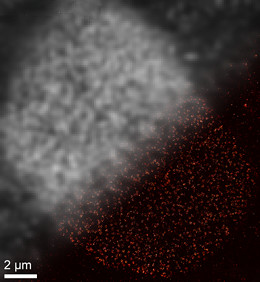Modified DNA aptamers enhance super-resolution microscopy

A pioneering study led by Ludwig Maximilian University of Munich (LMU) has demonstrated the use of chemically modified DNA aptamers as protein markers, enhancing the power of super-resolution fluorescence microscopy as an imaging tool.
The head of the study, Ralf Jungmann, set out to directly visualise the molecular interactions that take place within individual cells. In order to monitor the protein networks involved in such processes, Jungmann uses short DNA strands covalently attached to various fluorescence markers as probes to locate target proteins bearing complementary DNA tags.
By exploiting the sequence-specificity and versatility of DNA hybridisation in this way, it is possible to image the distributions of large numbers of molecules in single cells at super-resolution. The combination of DNA sequences with different fluorescent compounds explains why the technique bears the name DNA-PAINT.
One of the major restrictions on the potential of super-resolution fluorescence microscopy has to do with the markers employed to detect targets of biological interest — they are simply too big. As Jungmann explained, “We are working with an instrumental resolution of less than 10 nm, but the fluorescent labels conventionally used to tag proteins are much bigger than that. And this factor has hampered the progress of this whole field of research.”
This is what motivated the new study, which appears in the journal Nature Methods. Here, Jungmann and his colleagues explore the use of what are called SOMAmers, a special class of DNA aptamers, as a means of downsizing the markers used in DNA-PAINT.
The term ‘aptamer’ was originally coined to refer to single-stranded RNA molecules that fold into defined three-dimensional shapes and are able to specifically detect unique protein species. Jungmann’s aptamers are single-stranded DNA molecules, which fold into defined three-dimensional shapes that can bind directly to specifically targeted proteins.
“The ideal label used to tag proteins efficiently and specifically must fulfil several criteria,” said Sebastian Strauss, first author of the new study. “It should be as small as possible, and it should bind to targets stoichiometrically to enable precise quantitation. In addition, it would be ideal to synthesise whole libraries of these compounds and rapidly identify suitable markers for the proteins of interest.”
In order to assess the potential of DNA aptamers, the LMU team collaborated with American firm SomaLogic, which had already designed, for other purposes, a huge array of modified aptamers (SOMAmers) that can specifically bind thousands of different proteins. The Munich researchers modified a selection of these aptamers for DNA-PAINT and developed efficient labelling protocols for fixed and life cells.
The study shows that it is indeed possible to improve on the resolution attainable with conventional fluorescence labels using these novel labelling reagents in combination with DNA-PAINT super-resolution microscopy. According to Jungmann, “We expect that the new method will provide a significant boost for super-resolution microscopy, particularly with respect to its range of application in biology.”
Jungmann’s goal is to use DNA-PAINT to simultaneously visualise and monitor as many proteins and their interactions as possible. In future experiments, he and his colleagues plan to use the new labelling method to image whole protein networks at high resolution.
“We will be able to address biological and biomedical questions that have thus far been experimentally inaccessible,” he said.
A non-destructive way to locate microplastics in body tissue
Currently available analytical methods either destroy tissue in the body or do not allow...
Rapid imaging method shows how medicine moves beneath the skin
Researchers have developed a rapid imaging technique that allows them to visualise, within...
Fluorescent molecules glow in water, enhancing cell imaging
Researchers have developed a new family of fluorescent molecules that glow in a surprising way,...





